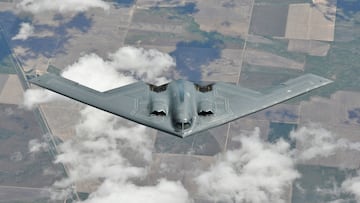This is the B-2, the “invisible” bomber used by the U.S. in its attack on Iran: features, cost, and destructive power
Conceived during the Cold War, the B-2 Spirit is a key piece in the United States’ military strategy in the 21st century, capable of reaching any target in the world.

On the evening of Saturday, June 21, President Donald Trump confirmed that the United States had carried out an airstrike on Iran, specifically targeting three nuclear facilities: Fordow, Natanz, and Isfahan, according to several media outlets. The bombers used were B-2s.
The B-2 Spirit, known as the world’s first low-observable or “stealth” strategic bomber, marked a turning point in military aviation. Conceived during the Cold War, this aircraft is based on the revolutionary designs of engineer Jack Northrop, whose innovative “flying wing” structure debuted in 1949 with the YB-49 prototype, although it was initially not adopted by the U.S. Air Force.
Manufactured by Northrop Grumman, this bomber is a key part of the United States’ strategic bomber modernization program. Its ability to carry both conventional and nuclear weapons makes it a powerful tool for deterrence and attack. Designed to penetrate the most sophisticated defenses, the B-2 Spirit can reach any target worldwide, including those protected by defense systems that were previously impenetrable.
Features of the “invisibility cloak”
The B-2 combines low-observable technologies with an efficient aerodynamic structure and a massive payload capacity of up to 40,000 pounds. Thanks to composite materials, special coatings, and its flying wing design, the bomber reduces its infrared, acoustic, electromagnetic, visual, and radar signatures, making it difficult to detect by advanced defense systems. These largely classified features make it a unique weapon of its kind.
The first B-2 was publicly unveiled on November 22, 1988, in California, with its maiden flight taking place on July 17, 1989. Since then, it has proven its effectiveness in multiple operations. During Operation Allied Force, for example, the B-2 was responsible for destroying 33% of Serbian targets in the first eight weeks, flying nonstop missions from Missouri to Kosovo and back.
In Operation Enduring Freedom, the B-2 completed one of its longest missions, covering the distance between its base in Whiteman, Missouri, and Afghanistan. During Operation Iraqi Freedom, it flew 22 sorties from forward bases and another 27 from the United States, dropping more than 1.5 million pounds of munitions.

A key asset in the 21st century
Although designed during a time of geopolitical tension, the B-2 remains an essential element in the United States’ military strategy in the 21st century. Its ability to operate at altitudes up to 50,000 feet and its intercontinental range—exceeding 6,000 miles without refueling—cement its status as a symbol of U.S. technological and military supremacy.
With a crew of only two pilots, compared to the five required for the B-52, the B-2 not only represents an advance in operational efficiency but also in strategic design. This stealth bomber, nicknamed the “invisibility cloak” of the skies, continues to be a powerful deterrent and a testament to the aeronautical ingenuity of its era.
Get your game on! Whether you’re into NFL touchdowns, NBA buzzer-beaters, world-class soccer goals, or MLB home runs, our app has it all.
Dive into live coverage, expert insights, breaking news, exclusive videos, and more – plus, stay updated on the latest in current affairs and entertainment. Download now for all-access coverage, right at your fingertips – anytime, anywhere.
Complete your personal details to comment